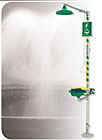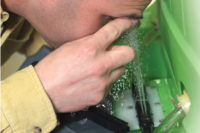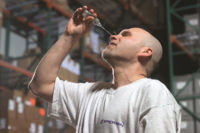
What keeps you up at night? For many business managers it’s the possibility of having one of their employees injured on the job. Could there be anything worse? The answer is “yes,†there sure could be. How about having an injured worker make a bee-line to the nearest emergency shower or eyewash and have it be inoperative or have it spray out rusty water. It also wouldn’t be Christmas morning to have your friendly OSHA representative visit and find those or a host of other conditions.
Avoiding such problems and many others is one of the reasons that there is the weekly activation requirement established by the ANSI Z358.1 standard. But, what all should be looked at, and what’s the difference between the weekly test and the more detailed annual inspection?
Weekly activation
ANSI Z358.1-2004 (section 4.6.2 and others) specifies that emergency showers, eyewashes and combination units “shall be activated weekly for a period long enough to verify operation and ensure that flushing fluid is available.†This requirement is designed to assure that you have verified the operational condition of the equipment. Additional notes in the standard clarify its intention “to ensure that there is a flushing fluid supply at the head of the device and to clear the supply line of any sediment build up that could prevent fluid from being delivered to the head of the device and to minimize microbial contamination due to sitting water.â€So, the somewhat mechanical function of activating drench showers and eyewashes weekly has a factual reason to be done, a more or less intuitive reason. But, what about the other aspects of emergency equipment design, installation and operation that can deteriorate or change over time? How about things like the requisite ten-second, unimpeded access to emergency showers and/or eyewashes? Is it possible that uninformed employees might have inadvertently placed obstacles in the path to showers and eyewashes? You bet!
It’s also possible that the condition of the spray heads can be altered by mineral buildup around the small holes that are designed to diffuse the spray pattern or some other subtly occurring change. So, taking one’s time and considering everything in the environment should also be part of the weekly review. The weekly activation and checks should be done using a checklist that assures that all required elements are reviewed.
Annual checkup
ANSI Z358.1 also specifies that a more detailed evaluation of emergency equipment facilities must be done annually. This much more thorough evaluation includes areas such as:- Individual shower/eyewash and total system overall operation;
- possible impacts of multiple simultaneous use of shower and/or eyewash equipment;
- Physical installation of equipment;
- Accessibility vs. the standard minimums;
- Establishing whether specific pieces of equipment are obsolete vs. current standard requirements; and
- Overall owner/management compliance to the standard.
Pragmatic assessment
During the annual safety survey, specific facility, drench shower and eyewash product capability and owner/management responsibilities are reviewed vs. standard requirements. A quality survey also includes a pragmatic assessment of the equipment used from a “real-world†use perspective. That is, beyond the letter of the law as established by ANSI, certain specific capabilities should be considered. Some examples might include:- Actuation — Stems in the actuator ball valves of showers and eyewashes should be constructed of stainless steel. While the standard is not specific enough to require this added feature, it mitigates the possibility of sheering off the stem when a panicked employee hits the actuator harder than might otherwise be anticipated. Likewise, pull-handles should be easy to see and grasp. Their design is critical, when viewed from the perspective of an injured employee, who is panicked and might have partially impaired vision. Interestingly, we still see pull chain-type equipment in use today. The challenge of having an injured worker grab a swinging chain, in the mental and physical condition they are likely to be in following an accident is incredible.
Recognizing that these types of situations still exist in well-run facilities today is one of the largest benefits of an annual survey performed by a third party. It would most likely look alright to people who don’t regularly deal with the new state-of-the-art in emergency equipment design. - Integral flow controls — While once again not a standard requirement, flow controls assure that the actual operation of the equipment will be conducive to victims using the equipment for the full 15-minute drench or irrigation protocol and receiving the maximum benefit. Integral flow controls assure that the pressure and spray pattern is consistent throughout the use cycle. Fluctuations in line pressure can cause surges and starvation, which can minimize diffused flow patterns, as well as victim comfort levels without flow controls.
- Flooring and drains — Finally, a third-party survey will consider collateral situations, such as the effects of shower/eyewash use on the surrounding areas. A drench shower will use about 300 gallons of water during a compliant use cycle.
Accommodations should be considered, even though not required, for disposing of or dealing with that much water. Drains should be available to handle the wastewater produced during a use cycle, and non-slip (matting or applied) surfaces should be incorporated into the overall design. Consideration should also be given as to whether the wastewater from shower or eyewash use can safely be disposed of in that manner.
Being assured
At first glance, the weekly and annual inspection provisions of Z358.1 might seem like mechanical exercises with little benefit to the company or its employees. But, the truth is that the testing and evaluations assure that the equipment is ready for use at any time and that it is up to date with not only the pure requirements of the standard, but the most current best engineering and designs available. Seeking the assistance of a third party to help with the evaluation makes sense, because it allows you to tap the knowledge base of emergency equipment design and manufacturing professionals who are in the best position to offer sound advice.So, go ahead and get a good night’s sleep!




